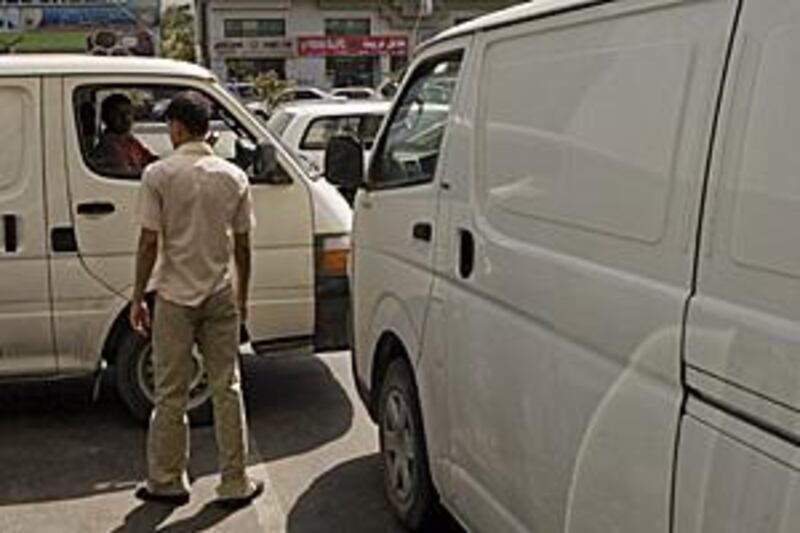There are many car names that trip easily off the tongue of people who have no interest in motoring at all. The Volkswagen Beetle, the Toyota Corolla, the Ford Fiesta - cars that, through their sheer volume of sales in countless countries around the world, have become household names. But there are other vehicles that, while they may have sold in the millions, are barely known, even to car fanatics.
They may pull up alongside at traffic lights or loom large in the rearview mirror, but on a certain level they remain invisible. These are the small commercial vehicles that ferry goods and people about and are the lifeblood of the UAE and countless other countries. In this country, there is little doubt which van reigns supreme: the Toyota Hiace. This is sold in various versions, ranging from a basic panel vehicle with metal sides to a wider model with seats and a raised roof. In whatever version it is sold, the Hiace is nothing if not functional - a straight front end, back and sides.
Its dominance spreads beyond the UAE - from South Africa to Kenya, from Thailand to Sri Lanka, the Hiace is the workhorse that functions as a cross-country minibus and a fill-it-until-it-bursts load carrier. According to Neil McIntee, editor of What Van? magazine, based in England, the Hiace's worldwide popularity is simple: it hardly ever goes wrong. "It's all down to reliability. It is bulletproof, the same as the Hilux pickup. It doesn't break down. You can overload it massively and it will still go," he says.
"Especially in countries with high temperatures, you don't want to break down in the middle of nowhere. It's the same in Australia - you have huge distances to cover in high temperatures." Among those who rely on the Hiace is Heva Sanavirthno, who lives in Matara on Sri Lanka's south coast and owns a 1991 model that spent the first few years of its life in Japan. In 1996, it was first registered in Sri Lanka and eight years later the vehicle was bought by Mr Sanavirthno.
Anyone who doubts the strength of these vehicles need only look at where the odometer of Mr Sanavirthno's Hiace sits now - the vehicle has done more than 480,000 kilometres. "Maintenance costs are very low. You don't have problems," he says. While the Hiace is the market leader here and in many other markets, and is now made by several Chinese manufacturers, it is far from being the only panel van that sells in large numbers.
Another popular model is the Nissan Urvan, which looks like an updated version of the old-model Hiace and is produced in both diesel and petrol variants. As with the Hiace, in many developing countries, this car is imported second-hand from Japan, where it is made. Prabath Sanjeewe, 31, is a taxi driver in the Sri Lankan coastal town of Galle, which attracts tourists for its impressive Dutch-built fort.
He has a 1992 model Nissan Urvan with a 2.5-litre diesel engine. He paid 600,000 Sri Lankan rupees (Dh19,349) for his 1992 10-seater model, which he uses as a taxi. "I like Nissans. They run well. This is a very good car," he says of his Urvan, which has racked up more than 290,000 kilometres. The versions of the Hiace and Urvan seen here and in developing countries are absent from European roads, where stricter safety regulations prevent the sale of flat-fronted vehicles in which the driver and front seat passenger sit on top of the engine. Instead, models of this class of van sold in Europe usually have a bonnet and an engine right at the front.
In countries where the Hiace and Urvan are popular, Japanese pickups also tend to be common sights on the roads. Again, a variety of shapes and sizes are sold, with some versions having just one row of seats, others two, while two-wheel drive and four-wheel drive models are made. Toyota's Hilux is a favourite, as Mitsubishi's curvy L200 and a slightly squarer model from Isuzu. So invisible is this class of vehicles, however, that when Nissan displayed one at the recent Abu Dhabi International Motor Show, it did not even come with a proper name: the vehicle's registration plate simply said "Pickup".
While Japanese manufacturers dominate in the invisible vehicle sector in much of the globe, there are plenty of markets where local car makers have cornered the market. For example, in many of the former Soviet republics, people rely on a van built by the Russian manufacturer Gaz, which also makes the legendary Volga model. Gaz's vans resemble a redesigned version of the Ford Transit, which is also abundant in the ex-Soviet states.
These vans are workhorses that keep whole countries functioning, acting in Armenia and Georgia, to name but two, as buses around town, long-distance transport and commercial load carriers. The models officially have names such as Gazelle and Sobol, but finding one of these badges on the rear door is next to impossible. These vehicles are as anonymous as they are common, as unrecognised as they are essential.
The Ford Transit, however, is one vehicle that has managed to transcend its original status as an invisible commercial vehicle and has slowly turned itself into a genuine icon, at least in the country where it is made. The Transit, which is not sold in the UAE, has a 40 per cent share of Britain's panel van market, helped by the fact that it is made in the UK. Its next closest competitor only has a 15 per cent market share.
"The word Transit has become a generic term for a panel van here," said Mr McIntee from his office in London. "If somebody wants to hire a panel van, they will say: 'I want to hire a Transit,' even if they end up getting something else." dbardsley@thenational.ae







